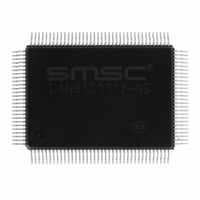LAN91C111I-NS SMSC, LAN91C111I-NS Datasheet - Page 30

LAN91C111I-NS
Manufacturer Part Number
LAN91C111I-NS
Description
IC ETHERNET CTLR MAC PHY 128-QFP
Manufacturer
SMSC
Type
Single Chip MAC and PHYr
Datasheet
1.LAN91C111-NU.pdf
(128 pages)
Specifications of LAN91C111I-NS
Controller Type
Ethernet Controller, MAC/PHY
Interface
Serial EEPROM
Voltage - Supply
3.3V
Operating Temperature
-40°C ~ 85°C
Mounting Type
Surface Mount
Package / Case
128-QFP
Product
Ethernet Controllers
Number Of Transceivers
1
Standard Supported
IEEE 802.3 or IEEE 802.3u
Data Rate
10 Mbps or 100 Mbps
Supply Voltage (max)
5 V
Supply Voltage (min)
0 V
Supply Current (max)
140 mA
Maximum Operating Temperature
+ 85 C
Ethernet Connection Type
100BASE-T or 100BASE-T4 or 100BASE-TX or 10BASE-T
Minimum Operating Temperature
- 40 C
Mounting Style
SMD/SMT
Lead Free Status / RoHS Status
Lead free / RoHS Compliant
Current - Supply
-
Lead Free Status / Rohs Status
Lead free / RoHS Compliant
Other names
638-1014
Available stocks
Company
Part Number
Manufacturer
Quantity
Price
Company:
Part Number:
LAN91C111I-NS
Manufacturer:
RECOM
Quantity:
1 000
Company:
Part Number:
LAN91C111I-NS
Manufacturer:
SMSC
Quantity:
1 000
Company:
Part Number:
LAN91C111I-NS
Manufacturer:
Standard
Quantity:
6 916
Company:
Part Number:
LAN91C111I-NS
Manufacturer:
Microchip Technology
Quantity:
10 000
10/100 Non-PCI Ethernet Single Chip MAC + PHY
Datasheet
If 25 consecutive descrambled idle pattern 1's are not detected within the 1ms interval, the descrambler
goes out of synchronization and restarts the synchronization process.
If the descrambler is in the unsynchronized state, the descrambler loss of synchronization detect bit is
set in the Ml serial port Status Output register to indicate this condition. Once this bit is set, it will stay
set until the descrambler achieves synchronization.
10 Mbps
A descrambler is not used in 10 Mbps mode.
Descrambler Bypass
The descrambler can be bypassed by setting the bypass scrambler/descrambler bit in the PHY MI
serial port Configuration 1 register. When this bit is set, the data bypasses the descrambler and goes
directly from the TP receiver to the 4B5B decoder.
7.7.7
Twisted Pair Transmitter
Transmitter - 100 Mbps
The TX transmitter consists of MLT-3 encoder, waveform generator and line driver.
The MLT-3 encoder converts the NRZ data from the scrambler into a three level MLT-3 code required
by IEEE 802.3. MLT-3 coding uses three levels and converts 1's to transitions between the three levels,
and converts 0's to no transitions or changes in level.
The purpose of the waveform generator is to shape the transmit output pulse. The waveform generator
takes the MLT-3 three level encoded waveform and uses an array of switched current sources to
control the rise/fall time and level of the signal at the Output. The output of the switched current
sources then goes through a low pass filter in order to "smooth" the current output and remove any
high frequency components. In this way, the waveform generator preshapes the output waveform
transmitted onto the twisted pair cable to meet the pulse template requirements outlined in IEEE 802.3.
The waveform generator eliminates the need for any external filters on the TP transmit output.
The line driver converts the shaped and smoothed waveform to a current output that can drive 100
meters of category 5 unshielded twisted pair cable or 150 Ohm shielded twisted pair cable.
Transmitter - 10 Mbps
The transmitter operation in 10 Mbps mode is much different than the 100 Mbps transmitter. Even so,
the transmitter still consists of a waveform generator and line driver.
The purpose of the waveform generator is to shape the output transmit pulse. The waveform generator
consists of a ROM, DAC, dock generator, and filter. The DAC generates a stair-stepped representation
of the desired output waveform. The stairstepped DAC output then goes through a low pass filter in
order to "smooth' the DAC output and remove any high frequency components. The DAC values are
determined from the ROM outputs; the ROM contents are chosen to shape the pulse to the desired
template and are clocked into the DAC at high speed by the clock generator. In this way, the waveform
generator preshapes the output waveform to be transmitted onto the twisted pair cable to meet the
pulse template requirements outlined in IEEE 802.3 Clause 14 and also shown in
Figure
7.4. The
waveshaper replaces and eliminates external filters on the TP transmit output.
The line driver converts the shaped and smoothed waveform to a current output that can drive 100
meters of category 3/4/5 100 Ohm unshielded twisted pair cable or 150 Ohm shielded twisted pair
cable tied directly to the TP output pins without any external filters. During the idle period, no output
signal is transmitted on the TP outputs (except link pulse).
Revision 1.91 (06-01-09)
30
SMSC LAN91C111 REV C
DATASHEET













